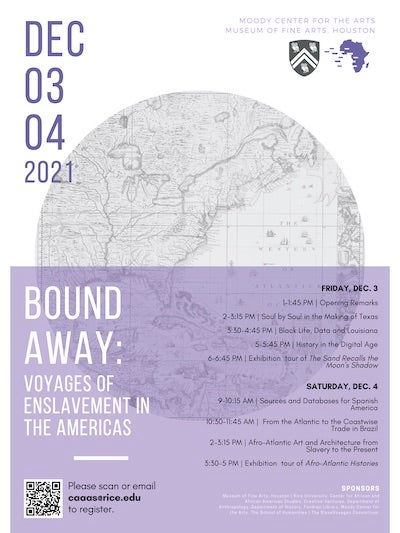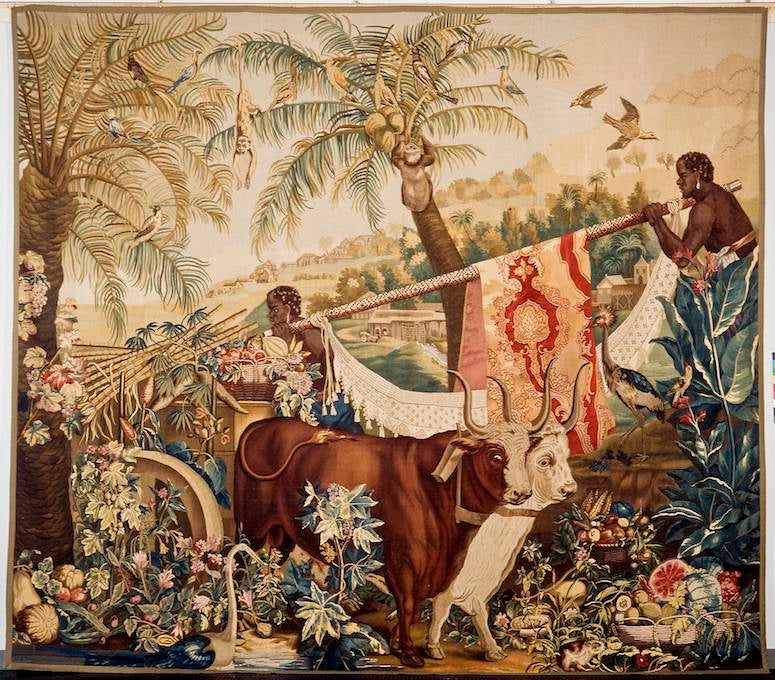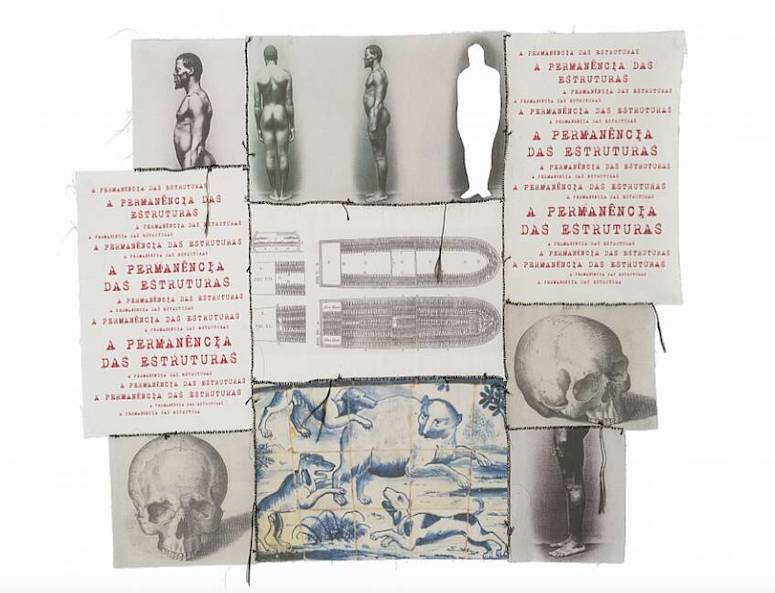Scholars from across the world will convene at the Moody Center for the Arts Dec. 3-4 for a Rice University conference sharing new findings about the intra-American slave trade.

“Bound Away: Voyages of Enslavement in the Americas” will also recognize Rice’s new role as host of the SlaveVoyages database, the largest online repository of records on the slave trade.
The conference is being held in collaboration with the Museum of Fine Arts, Houston (MFAH) and the Moody, and concludes both days with an exhibition tour at each institution, offering exposure to art that will inform and contextualize the research presented at the conference and vice versa.
“Afro-Atlantic Histories,” the critically acclaimed exhibition from Sao Paulo, recently made its United States debut at the MFAH. The Moody is currently hosting artist Kapwani Kiwanga’s first solo exhibition in Houston, “The Sand Recalls the Moon’s Shadow.”
Daniel Domingues, associate professor of history, organized the “Bound Away” conference and even contributed to the MFAH’s audio guide for “Afro-Atlantic Histories.” Domingues stewards the SlaveVoyages website at Rice and its treasure trove of data, which transitioned to Rice in 2021 after 20 years at Emory University. SlaveVoyages is considered the gold standard in digital humanities.
“It is a tremendous deal,” Domingues said. “Rice University is now sitting behind the steering wheel of SlaveVoyages, so it’s shaping what people all over the world are learning about the history of the slave trade, and it's doing that at this particular juncture when the country, the state and we as an institution are all going through this reckoning in the way we study and think about slavery.”
In 2019, the SlaveVoyages website launched a new database to help trace intra-American passages, which were underrepresented in the data. In 2020, it received a grant to expand the database further by adding new voyages of ships that transported enslaved people between ports in the United States, Spanish America and Brazil.
“Bound Away” will report some of those findings. It will also officially recognize the formation of the SlaveVoyages Consortium — a group of universities including Rice, Emory, the Hutchins Center for African and African American Research at Harvard University, the National Museum of African American History and Culture, the Omohundro Institute of Early American History and Culture at William & Mary and three campuses at the University of California dedicated to funding and maintaining the SlaveVoyages website.
A shared commitment to retelling narratives
The conference also highlights ongoing partnerships between Rice and the MFAH, with its two campuses only a half-mile apart. When Domingues saw that “Afro-Atlantic Histories” would be in Houston at the same time as “Bound Away,” he knew he had to connect the conference with the MFAH.
Coincidentally, Rice grad student Lynne Lee was already working at the MFAH as part of her Camfield Fellowship, which offers art history students the opportunity to intern under the guidance of a professional museum curator for a year. Her specialty? Afro-Brazilian modernism and its trans-Atlantic network.
“It was just this constellation of events that happened where collaboration made perfect sense, and this is a lovely way for the public to see how we collaborate and the goals that we share, which are in the area of educating and training university students,” said Caroline Goeser, the MFAH’s W.T. and Louise J. Moran Chair of Learning and Interpretation, who worked with Domingues in bringing the MFAH into the conference.

Lee will present the research she’s conducted so far at the MFAH as part of a panel that’s taking place in the museum’s Brown Auditorium Dec. 4 on “Afro-Atlantic Art and Architecture from Slavery to the Present.” She’ll speak alongside fellow Hermann von Hesse, the Mellon-Sawyer Postdoctoral Fellow at Rice’s Center for African and African American Studies, and Roberto Conduru, the Endowed Distinguished Professor of Art History at Southern Methodist University.
“We are very committed to retelling narratives about art, the history of art and the history of culture, and the ‘Afro-Atlantic Histories’ exhibition allows us to tell a fuller narrative about the enslavement of Africans across the African diaspora by making it a story not only of enslavement but also resilience and power,” Goeser said. “I feel like that's where Daniel is coming from as well — with this conference and with SlaveVoyages — so we're thrilled to host a session of the conference at the museum.”
All other “Bound Away” panels will take place in the Moody’s Lois Chiles Studio Theater, beginning at 1 p.m. Dec. 3 with opening remarks from Domingues and fellow Rice history professor Alexander Byrd, the vice provost of diversity, equity and inclusion and co-chair of Rice’s Task Force on Slavery, Segregation and Racial injustice, and Greg O’Malley, the University of California, Santa Cruz historian and co-principal investigator on the grant to expand the intra-American database.
History through a new lens
The first panel of the conference explores slavery in Texas, and features research presented by historians Daina Ramey Berry, chair of the history department at the University of Texas at Austin, and professor Sean Kelley of Essex University. Two Rice undergrads, Katelyn Landry and Victoria Zabarte, will present alongside the professionals, sharing their work in locating and adding Texas records to the SlaveVoyages website. It previously had none.
“They provocatively titled their presentation ‘Where is Texas on the SlaveVoyages Website?’ because when it moved to Rice, the students noticed that Texas was not even coded in the website,” Domingues said. ”There was no information about ships bringing enslaved people to Texas, so they decided to take matters into their own hands.”
They were able to document about 15,000 enslaved people who were transported from New Orleans; Savannah, Georgia; and Mobile, Alabama, to ports all along the Texas coast, a number Domingues said “should be regarded as a minimum.” This shows Texas as an active participant during its time as an independent republic and, as records demonstrate, even more involved in the trade once it joined the United States as a slave state in 1845.

Additional panels will focus on “Black Life, Data and Louisiana,” “History in the Digital Age,” “Sources and Databases for Spanish America” and “From the Atlantic to the Coastwise Trade in Brazil,” and will feature historians from Vanderbilt University, the University of British Columbia and the Federal University of Alagoas in Maceió, Brazil, among others. The first day of the conference will conclude with a tour of “The Sand Recalls the Moon’s Shadow” by Moody curator Ylinka Barotto.
“We’re delighted to host this important conference at the Moody Center for the Arts, especially in light of our current exhibition by Kapwani Kiwanga, whose creative practice takes research as its starting point, in order to explore the global implications of history on the contemporary world,” said Alison Weaver, the Suzanne Deal Booth Executive Director of the Moody.
At the MFAH, curators Alison de Lima Greene and Anita Bateman will lead a tour of the “Afro-Atlantic Histories” following the second day of panels. Like the decades of work contained in the SlaveVoyages database, the exhibition spans cultures and time in its presentation of an important part of our shared world history that continues to have implications today, noted Katie O’Hara, the MFAH’s curatorial assistant who’s worked closely with Domingues and Lee on this collaboration.
“Rice’s SlaveVoyages project provides a wonderful amount of research that people can tap into, while this exhibition provides a different way of looking at history through the lens of an artist,” O’Hara said. “It gives you an opportunity to feel empathy in ways that you might not be able to if you're only looking at a document.”
Combining research and art in this way was important to Domingues too, bringing a vital form of expression to the data.
“SlaveVoyages is a primarily quantitative project, focusing on numbers of people transported from one part of the Atlantic to another,” he said. “But with ‘Bound Away,’ we’re mixing that with art exhibitions displaying works made by African people and artists of African ancestry that are portraying their own history and experiences and culture.”
“Bound Away: Voyages of Enslavement in the Americas,” Dec. 3-4, Moody Center for the Arts and Museum of Fine Arts, Houston. Free and open to the public. “Bound Away” is sponsored by Rice University’s Center for African and African American Studies, Creative Ventures Fund, Department of Anthropology, Department of History, Fondren Library, Moody Center for the Arts and School of Humanities Dean’s Office, in partnership with the Museum of Fine Arts, Houston, and the SlaveVoyages Consortium.

